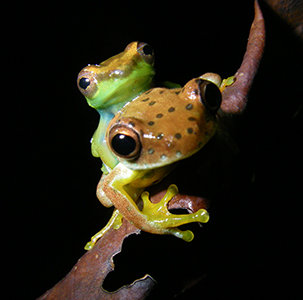Sexual Dichromatism in Frogs
By Rayna Bell, Cornell University, August 2012
Sexual dichromatism, a form of sexual dimorphism in which males and females differ in color, is widespread in animals but has been predominantly studied in birds (Kimball and Ligon 1999, Badyaev and Hill 2003), fishes (Kodric-Brown 1998), and butterflies (Allen et al 2011). We have now documented sexual dichromatism in over 120 species (see Table 1; Bell and Zamudio 2012), but both its function and evolution remain poorly understood.
Within frogs, we make a distinction between two broad classes of sexual dichromatism. In the first class, which we refer to as dynamic dichromatism, males undergo a temporary color change during the breeding season. The duration of this dynamic color change varies across species from only a few hours (e.g Incilius luetkenii (Doucet and Mennill 2010)) to several days or weeks during the breeding season (e.g. Rana temporaria (Hedengren 1987)). In the second class of dichromatism, which we refer to as ontogenetic dichromatism, either males or females undergo a permanent color and/or color pattern change, generally at the onset of sexual maturation. The degree of color differentiation between the sexes ranges from subtle differences in shade (e.g. Scaphiophryne gottlebei (Glaw and Vences 1994)) to dramatic differences in both color and pattern (e.g. Hyperolius argus (Stewart 1967)).
We distinguish between the two classes of dichromatism (dynamic and ontogenetic), and their respective phylogenetic distributions, because they may have important differences in terms of evolutionary lability and function. Dynamic sexual dichromatism is especially prevalent in the Ranidae, Bufonidae and Hylidae but due to its ephemeral nature, this class of dichromatism is likely under-documented in the literature and may be far more common among frogs. In particular, we anticipate future records of dynamic dichromatism within lineages where it has already been documented and is fairly common (e.g. Bufonidae). Ontogenetic dichromatism appears to be more taxonomically widespread but the vast majority of these dichromatic species are in the Hyperoliidae, Bufonidae and Hylidae.
Broad ecological factors, such as latitude and range size, correlate with the global distribution of sexual dichromatism in other vertebrates (Badyaev and Hill 2003, Friedman et al 2009) and these macroecological patterns point to specific mechanisms driving the distribution of sexual dichromatism; some of these mechanisms may also be relevant in frogs. For example, birds exhibit higher prevalence of dichromatism in temperate regions, and this pattern may result from increased predation pressure at high latitudes (Martin 1996) resulting in reduced coloration in females (Badyaev and Hill 2003). Conversely, sexual dichromatism in frogs appears to be more common among tropical than temperate species.
Although we are rapidly gathering data on the distribution of sexual dichromatism among frog species, we still know very little about the function of sexual dichromatism in this group of vertebrates. Studies that focus on lineages in which dynamic or ontogenetic dichromatism evolve repeatedly hold the most promise for addressing hypotheses about the origin and maintenance of this phenotype in frogs as well as other groups of dichromatic organisms.
References:
Allen, C.E., Zwaan, B.J., Brakefield, P.M. 2011 Evolution of sexual dimorphism in the Lepidoptera. Annual Reviews of Entomology 56, 445-464.
Badyaev, A.V., Hill, G.E. 2003 Avian sexual dichromatism in relation to phylogeny and ecology. Annual Reviews of Ecology, Evolution and Systematics 34, 27-49.
Bell, R.C., Zamudio K.R. 2012 Sexual dichromatism in frogs: natural selection, sexual selection, and unexpected diversity. Proceedings of the Royal Society, B.
Doucet, S.M., Mennill, D.J. 2010 Dynamic sexual dichromatism in an explosively breeding neotropical toad. Biology Letters 6, 63-66.
Friedman, N.R., Hofmann, C.M., Kondo, B., Omland, K.E. 2009 Correlated evolution of migration and sexual dichromatism in the new world orioles (Icterus). Evolution 63, 3269-3274.
Glaw, F., Vences, M. 1994 A Field Guide to the Amphibians and Reptiles of Madagascar. Koln: Moos-Druck, Leverkusen.
Hedengren, I. 1987 Selection on body size, arm length and color in male and female Moor Frogs (Rana arvalis). M.Sc. Thesis, Section of Ethology, Department of Zoology, University of Stockholm, Stockholm.
Kimball, R.T., Ligon, J.D. 1999 Evolution of avian plumage dichromatism from a proximate perspective. American Naturalist 154, 182-193.
Kodric-Brown, A. 1998 Sexual dichromatism and temporary color changes in the reproduction of fishes. American Zoologist 31, 70-81.
Martin, T.E. 1996 Life history evolution in tropical and south temperate birds: What do we really know? Journal of Avian Biology 27, 263-272.
Stewart, M.M. 1967 Amphibians of Malawi. State University of New York Press, Albany.

